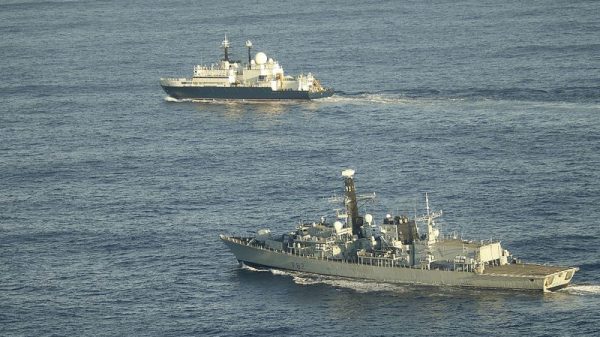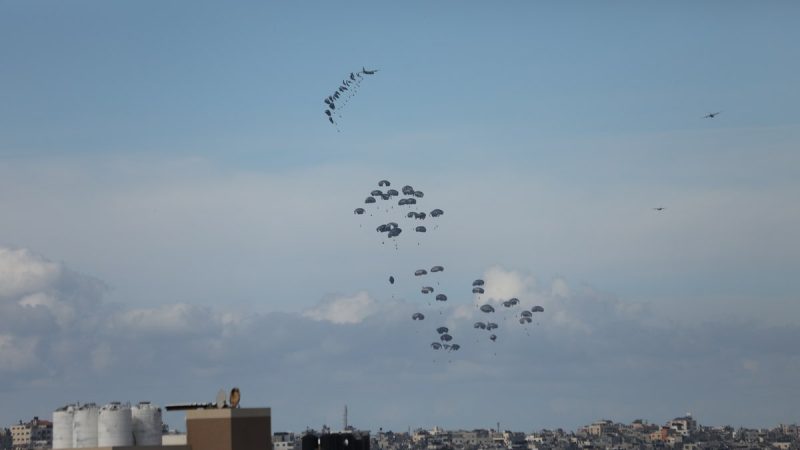JERUSALEM – As the U.S. leads a united effort with other nations and international agencies aimed at getting more aid into the war-torn Gaza Strip, critics say the aid coordination is a mess and convoys are being attacked, with the bulk of what is being sent not even reaching the most vulnerable.
Over the past two weeks, more than 500 bundles containing hundreds of thousands of meals have been airdropped into the enclave by countries such as the United Arab Emirates, Jordan, Egypt and France, as well as the U.S. On Tuesday, a ship packed with almost 200 metric tons of food set sail for the Strip from Cyprus. Facilitated by the World Central Kitchen, an NGO that provides food aid, the ship is set to reach the enclave’s shores on Thursday, though it is unclear how it will unload with no pier or harbor.
Israeli and U.N. officials have expressed concern that both the airdrops and the maritime efforts are inefficient and ineffective, and do not negate the need for someone on the ground to ensure it reaches those who really need it. There has also been criticism from Gazans, who say the aid is self-serving and, in some cases, not appropriate for their needs.
‘I don’t think anyone really knows what is going on, and we are only hearing complaints that it is not enough, that it is not going to the right people and that it is too little too late,’ Khaled Abu Toameh, a Palestinian affairs analyst based in Jerusalem, told Fox News Digital.
‘I haven’t seen one person saying that this is great and now we are happy,’ he said, adding that there have only been complaints from the people in Gaza that the food being sent is expired or that it is not Halal, he claimed.
Multiple videos shared online over the past week showed Palestinians criticizing the airdrop initiative, complaining that the food being dropped was not appropriate and that it was being done for each country’s own self-interest.
One video showed a Palestinian man complaining about the items contained inside the airdropped packages, saying the food being distributed by the U.S. was not suitable for Arabs. In another short clip, a man identified as Ibrahim from Gaza filmed himself throwing the American aid package into the trash, stating: ‘I don’t want aid from a country that is an accomplice to our starvation and genocide.’
Another video showed Palestinian men running to retrieve the airdropped packages and there were reports from inside the Strip that at least one person had been killed by the falling aid.
Wes J. Bryant, a retired master sergeant and senior special operations joint terminal attack controller (JTAC) in the elite special warfare branch of the U.S. Air Force, said that based on video footage, the airdrops appeared to have been carried out hastily and over significant urban areas, which was in contrast with standard U.S. Air Force protocols.
‘This is a concern and would not be done in any setting that a U.S. Drop Zone controller were present – unless absolutely needed,’ he said. ‘These packages are typically pallets with loads of boxes of supplies, secured by netting, and with a chute that deploys upon being pushed out the aircraft ramp. They are very heavy and even when chutes are deployed, they still come in hard and can be deadly.’
Bryant said he was confused by footage of the drops and believes that a trusted source should have been solicited on the ground, ‘not only assist with any drops but corral populace for safety.’
Jamie McGoldrick, the U.N.’s humanitarian coordinator ad interim for the Occupied Palestinian Territory, told Fox News Digital that while he welcomed any initiative to get more food into the Strip, especially into the north, via whatever means, the sea and air efforts were not cost-effective or efficient.
‘A plane load of 20 or 18 tons of aid costs about $180,000, that is very expensive, and it is about half the weight of an average truck that can take about 20 and 30 kilos of aid, or about 20-30 metric tons, so you can see the cost differentials,’ he said. ‘Trucks are much, much cheaper, and you can get much more for your money.’
McGoldrick said the problem with the airdrops was there was no guarantee where the packages would land and if the people who really needed them would be able to intercept them. He also said that while the maritime initiative was ‘great,’ there would also be a need to transfer the aid using trucks and on roads that were ‘prone to looting and ransacking.’
He said a more effective option would be for Israel to open up more land crossings in order for Gaza to be ‘flooded’ with food aid, which would reduce the overall basic needs of the people, reducing the need for looting and thus allowing aid agencies to help those who are more vulnerable.
On Tuesday, COGAT, the Israeli military unit that coordinates civilian matters with the Palestinian Authority, announced that it had allowed six trucks filled with aid to enter Gaza via a newly opened crossing in the northern part of the Strip.
A statement by the World Food Program confirmed that enough food for 25,000 people had been successfully delivered to Gaza City for the first time since Feb. 20, but also warned that this – as well as other aid efforts – were not enough.
Israeli army spokesman Rear Admiral Daniel Hagari confirmed to Fox News Digital on Thursday reports that the army was working on a plan to ‘flood’ Gaza with humanitarian aid and was consulting with CENTCOM on how exactly to do this.
‘With people in northern Gaza on the brink of famine, we need deliveries every day and we need entry points directly into the north,’ the U.N. agency said in a statement.
Shimon Freedman, COGAT’s international media spokesperson, told Fox News Digital that Israel had not placed ‘any limits on the amount of aid going in’ and that the main barrier was in distributing the aid.
‘In terms of what is standing in the way of more aid, it is an issue of distribution not inspection,’ he said, adding that COGAT, which monitors the situation on the ground from its base in southern Israel, was ‘happy to coordinate more convoys to the north.’
Israel currently inspects all aid going into Gaza at two land crossings – one in Nitzana, where the aid then enters the Strip via the Rafah crossing from Egypt, and the other at Kerem Shalom, on the border with Israel. Once inside, it is up to international aid agencies, including those affiliated with the United Nations, to distribute the goods among the needy even as the situation on the ground has become more volatile with armed groups, including Hamas, stealing the aid.
He said Israel has been working to increase and streamline its inspections and now had the ability to process as many as 44 trucks an hour. More aid trucks are entering Gaza than previously, Freedman said, describing how over the past few weeks up to 200 truckloads of aid were just left waiting for aid agencies to distribute the goods.
Freedman said that over the past two weeks, Israel had coordinated with the U.S. and its partners more than 30 airdrops with some 500 packages reaching the northern part of the Strip.
On Wednesday, Secretary of State Antony Blinken, perhaps reacting to the criticism regarding aid deliveries, spoke to the press following a video conference call with representatives from Cyprus, the U.N. and other interested parties, and noted that they were coordinating efforts to get the maritime corridor ‘up and running.’
Blinken told reporters that ‘The bottom line is we need to see – as we’ve described it, we need to see flooding the zone when it comes to humanitarian assistance for Gaza.’
The U.S. has been the largest provider of aid to Gaza, handing out more than $180 million in assistance to Palestinians there since Oct. 7.







































